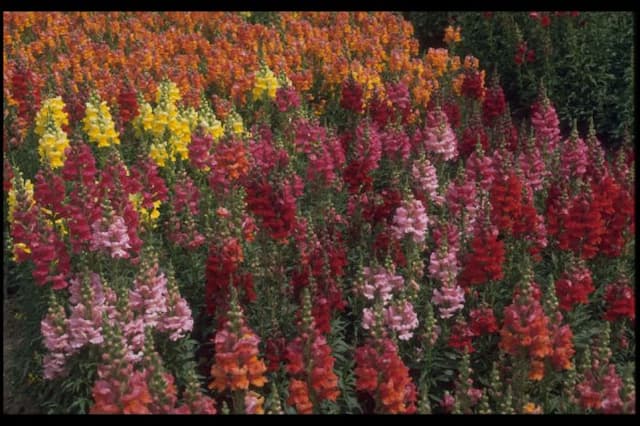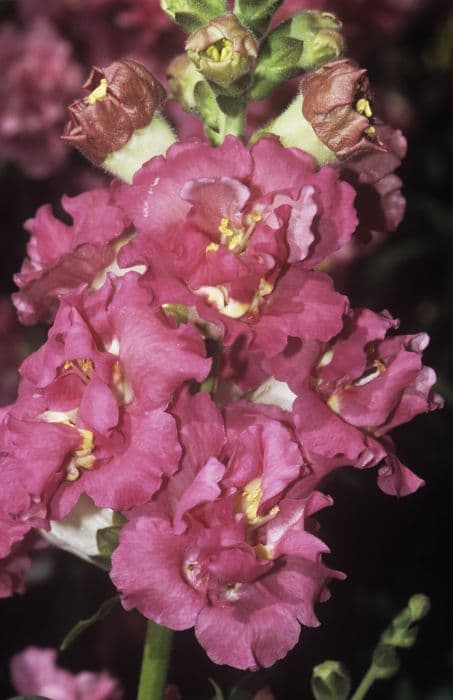Beardtongue Penstemon 'Bubblegum' (Ice Cream Series)

ABOUT
The Penstemon 'Bubblegum' from the Ice Cream Series is a visually delightful perennial known for its vivid and showy blooms. This plant boasts tubular flowers that resemble little bells, which come in a striking shade of bubblegum pink. These blossoms are clustered together at the tips of sturdy stems, creating a dense and colorful display that can add a lively touch to any garden setting. The leaves of the 'Bubblegum' Penstemon are narrow and elongated, with a lush green hue that provides a lovely contrast to the bright flowers. The foliage tends to form a neat and tidy mound, from which the flower-laden stems emerge, creating a balanced and attractive form overall. The texture of both the leaves and flowers is worth noting, as it adds to the sensory experience of the plant. The leaves are somewhat glossy, catching the light and contributing to the plant's vibrant presence in the garden. The flowers have a somewhat softer appearance, inviting close-up inspection and adding a more delicate touch. Throughout its blooming season, the 'Bubblegum' Penstemon can become a favorite for local pollinators, such as hummingbirds and butterflies, making it not only a visually appealing choice for gardeners but also a beneficial one for supporting biodiversity. The contrast between the green foliage and pink flowers, together with the plant's overall shape and texture, makes it a standout in ornamental plantings and mixed borders.
About this plant
 Names
NamesFamily
Plantaginaceae
Synonyms
Beardtongue, Balloon Flower
Common names
Penstemon 'Bubblegum' (Ice Cream Series)
 Toxicity
ToxicityTo humans
Penstemons, including the Penstemon 'Bubblegum', are generally not known to be toxic to humans. However, it is always advisable to avoid ingesting plants that are not recognized as safe to eat. There are no widely recognized symptoms of poisoning from Penstemons because they are not known to be poisonous to humans. Nonetheless, it's still possible for individuals to have allergic reactions or sensitivity to plants, so it is best to exercise caution and not consume any parts of the plant.
To pets
Penstemons, including the Penstemon 'Bubblegum', are not commonly listed as toxic to pets such as dogs and cats. Therefore, if a pet were to ingest a small amount of this plant, it is unlikely to cause serious harm or show symptoms of poisoning. However, ingestion of large amounts of non-food plants can sometimes lead to gastrointestinal upset in pets, such as vomiting or diarrhea, so it is wise to monitor your pet and prevent them from eating garden plants. If any adverse reactions are observed, contacting a veterinarian is recommended.
 Characteristics
CharacteristicsLife cycle
Perennials
Foliage type
Deciduous
Color of leaves
Green
Flower color
Pink
Height
2 feet (60 cm)
Spread
2 feet (60 cm)
Plant type
Herb
Hardiness zones
5
Native area
North America
Benefits
 General Benefits
General Benefits- Attracts Pollinators: The Penstemon 'Bubblegum' is known for attracting bees, butterflies, and other beneficial pollinators to the garden.
- Low Maintenance: It requires minimal upkeep once established, making it ideal for gardeners seeking plants that do not need a lot of attention.
- Drought Tolerant: This plant is able to withstand dry periods, making it suitable for xeriscaping and regions with water restrictions.
- Long Blooming Period: It produces attractive flowers over a long period, usually from late spring to early fall, offering extended visual interest.
- Colorful Landscape Addition: With vibrant pink flowers, it adds a splash of color to garden beds, borders, and container plantings.
- Cold Hardy: The plant is resistant to cold temperatures, enabling it to thrive in cooler climates where other perennials might fail.
- Deer Resistant: Generally, it is not preferred by deer, which makes it a good option for gardens in areas with high deer populations.
 Medical Properties
Medical PropertiesThis plant is not used for medical purposes.
 Air-purifying Qualities
Air-purifying QualitiesThis plant is not specifically known for air purifying qualities.
 Other Uses
Other Uses- Penstemon 'Bubblegum' can be used in art projects such as pressed flower crafts, where its bright flowers add a pop of color to bookmarks, cards, and other decorative items.
- In photography, the vibrant hues of Penstemon 'Bubblegum' make it an attractive subject for botanical photography and contribute to creating vivid garden landscapes.
- As a teaching tool in horticulture classes, this plant can help students learn about pollinator-friendly garden practices and the importance of bees and butterflies in our ecosystem.
- Penstemon 'Bubblegum' can be used in culinary presentations; though not edible, its petals can ornately accent plating for dishes, especially in high-end restaurants looking for floral aesthetics.
- It can serve as a natural dye source for fabrics or paper, utilizing the pigments from the petals to create a range of pink tones.
- The plant's stems and foliage can be included in compost piles, as they decompose to add nutrients and organic matter back into the garden soil.
- During educational garden tours, Penstemon 'Bubblegum' can be highlighted as an example of drought-tolerant landscaping, suitable for water-wise gardens.
- In the creation of natural potpourris, dried Penstemon 'Bubblegum' flowers can be mixed with other aromatics to provide a visually appealing and subtly scented blend.
- For craft workshops, the plant can be used to create botanical prints, where the flower and leaf shapes are inked and pressed onto paper to make unique art pieces.
- Penstemon 'Bubblegum' can be used as a natural pest repellent in gardens; its presence may deter certain insects from more susceptible plants.
Interesting Facts
 Feng Shui
Feng ShuiThe plant Penstemon is not used in Feng Shui practice.
 Zodiac Sign Compitability
Zodiac Sign CompitabilityThe plant Penstemon is not used in astrology practice.
 Plant Symbolism
Plant Symbolism- Attraction: The vibrant colors of Penstemon, often used in ornamental gardens, symbolize an attraction both in a romantic and aesthetic sense, drawing the eye and heart of viewers.
- Diversity: Penstemons are known for their wide range of colors and forms, which can reflect the value of diversity and variety in life.
- Endurance: As Penstemon is a hardy plant that can thrive in tough conditions, it symbolizes endurance and the ability to withstand challenges.
- Health: The Penstemon plant is sometimes associated with health and vitality due to its robust nature and the rich colors of its flowers.
- Communication: In the language of flowers, Penstemons can represent a message to speak freely or boldly, in line with their showy and unmissable presence in a garden.
 Water
WaterThe Beardtongue should be watered regularly, aiming for about 1 inch of water per week, either from rainfall or supplemental watering. The best method is to water deeply and less frequently, which encourages strong root development. During the growing season, depending on the weather and soil conditions, this may translate to watering every 5 to 7 days. It's important to avoid over-watering and to let the soil dry slightly between watering sessions. For potted plants or in very hot weather, the frequency may increase, and you may need to provide up to 1.5 gallons of water to ensure the soil is moistened thoroughly throughout the pot.
 Light
LightBeardtongue thrives best in full sun to partial shade conditions. The ideal spot for this plant is one where it can enjoy at least 6 hours of sunlight daily. However, in extremely hot climates, some afternoon shade is beneficial to prevent scorching of the leaves and flowers.
 Temperature
TemperatureBeardtongue prefers moderate temperatures and can typically withstand a range where the minimum doesn't drop below 0 degrees Fahrenheit and the maximum stays below 90 degrees Fahrenheit. The ideal temperature range for the Beardtongue is between 50 and 80 degrees Fahrenheit for optimal growth and flowering.
 Pruning
PruningBeardtongue should be pruned to encourage bushier growth and more prolific blooms. Deadheading, or removing spent flowers, will keep the plant looking tidy and may promote a second flush of blooms. Pruning back the foliage by about a third after the first flowering cycle can also rejuvenate the plant. The best time to prune heavily is in late winter or early spring, just before new growth begins.
 Cleaning
CleaningAs needed
 Soil
SoilThe Beardtongue prefers well-draining soil with a mix of loam and sand, amended with organic material like compost. Ideal pH should be slightly acidic to neutral, ranging from 6.0 to 7.0.
 Repotting
RepottingBeardtongues should be repotted every 2-3 years to refresh the soil and prevent root crowding. It's best done in the spring before new growth starts.
 Humidity & Misting
Humidity & MistingBeardtongues are tolerant of various humidity levels but thrive best in moderate conditions, not requiring any special humidity adjustments.
 Suitable locations
Suitable locationsIndoor
Place Beardtongue near a sunny window and keep soil lightly moist.
Outdoor
Grow Beardtongue in well-draining soil with full to partial sun.
Hardiness zone
4-9 USDA
 Life cycle
Life cycleThe Penstemon 'Bubblegum', also known as Beardtongue, begins its life as a seed, typically sown in spring after the threat of frost has passed. Upon germination, the seedling emerges and develops into a vegetative plant, forming a rosette of foliage at ground level. As the plant matures, it enters the vegetative growth stage, producing stems and leaves, and increasing in size. In the flowering stage, usually in late spring to early summer, Penstemon 'Bubblegum' produces showy pink tubular flowers that attract pollinators such as bees and hummingbirds. After pollination, the flowers develop into seed capsules that eventually release seeds, completing the reproductive cycle. The plant is a perennial, which means it can survive through multiple seasons, typically dying back in winter and re-emerging from the same root system in spring.
 Propogation
PropogationPropogation time
Spring-Early Summer
The most popular method of propagating the Penstemon 'Bubblegum' from the Ice Cream Series is by cuttings, which is best done in late spring or early summer when the plant is actively growing. To propagate, select a healthy stem and cut a 3- to 4-inch (approximately 7.5 to 10 cm) section just below a node. Remove the lower leaves and dip the cut end into a rooting hormone powder to encourage root formation. Next, plant the cutting in a well-draining potting mix, ensuring at least one node is buried where new roots can form. Keep the soil moist but not waterlogged and cover with a plastic bag or place in a propagator to maintain high humidity around the cutting. Roots typically develop in 3 to 4 weeks, at which point the new plants can be gradually acclimated to less humid conditions before transplanting outdoors.





![Snapdragon [Pretty in Pink]](/_next/image?url=https%3A%2F%2Fplants-admin.emdemapps.com%2Fimages%2Fplants%2F%2Fimages%2F604b5cb3b5385.png&w=640&q=75)



